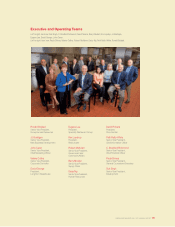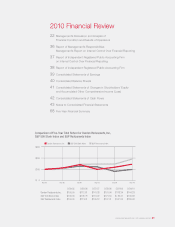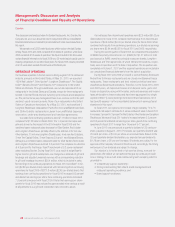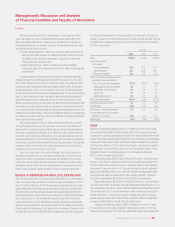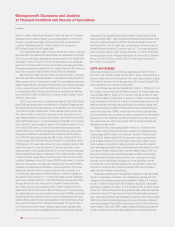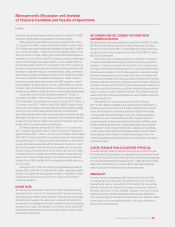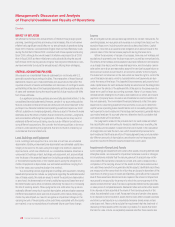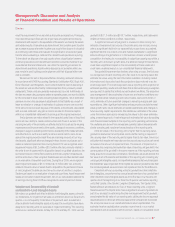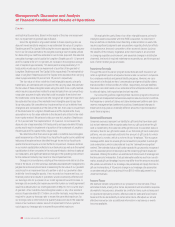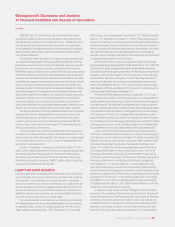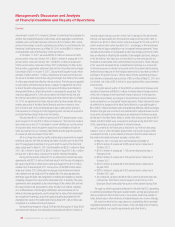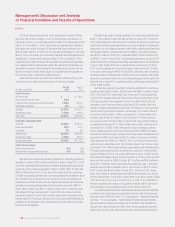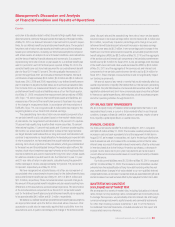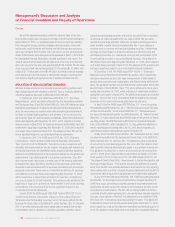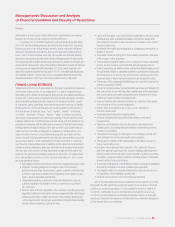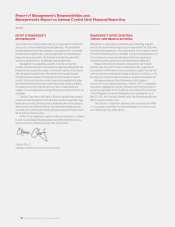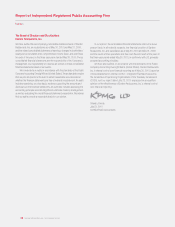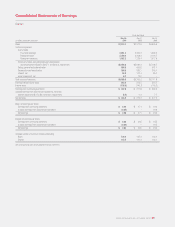Red Lobster 2010 Annual Report Download - page 31
Download and view the complete annual report
Please find page 31 of the 2010 Red Lobster annual report below. You can navigate through the pages in the report by either clicking on the pages listed below, or by using the keyword search tool below to find specific information within the annual report.
DARDEN RESTAURANTS, INC. | 2010 ANNUAL REPORT 29
Notes to Consolidated Financial Statements
Darden Restaurants
DARDEN RESTAURANTS, INC. | 2010 ANNUAL REPORT 29
Management’s Discussion and Analysis
of Financial Condition and Results of Operations
Darden
FASB ASC Topic 740, Income Taxes, requires that a position taken or
expected to be taken in a tax return be recognized (or derecognized) in the
financial statements when it is more likely than not (i.e., a likelihood of more
than fifty percent) that the position would be sustained upon examination
by tax authorities. A recognized tax position is then measured at the largest
amount of benefit that is greater than fifty percent likely of being realized
upon ultimate settlement.
We provide for federal and state income taxes currently payable as well
as for those deferred because of temporary differences between reporting
income and expenses for financial statement purposes versus tax purposes.
Federal income tax credits are recorded as a reduction of income taxes.
Deferred tax assets and liabilities are recognized for the future tax consequences
attributable to differences between the financial statement carrying amounts of
existing assets and liabilities and their respective tax bases. Deferred tax assets
and liabilities are measured using enacted tax rates expected to apply to taxable
income in the years in which those temporary differences are expected to be
recovered or settled. The effect on deferred tax assets and liabilities of a change
in tax rates is recognized in earnings in the period that includes the enactment
date. Interest recognized in accordance with reserves for uncertain tax positions
is included in interest, net in our consolidated statements of earnings. A
corresponding liability for accrued interest is included as a component of
other current liabilities in our consolidated balance sheets. Penalties, when
incurred, are recognized in selling, general and administrative expenses.
We base our estimates on the best available information at the time that
we prepare the provision. We generally file our annual income tax returns
several months after our fiscal year-end. Income tax returns are subject
to audit by federal, state and local governments, generally years after the
returns are filed. These returns could be subject to material adjustments or
differing interpretations of the tax laws.
The major jurisdictions in which the Company files income tax returns
include the U.S. federal jurisdiction, Canada, and most states in the U.S. that
have an income tax. With a few exceptions, the Company is no longer subject
to U.S. federal, state and local, or non-U.S. income tax examinations by tax
authorities for years before 2001.
Included in the balance of unrecognized tax benefits at May 30, 2010
is $0.3 million related to tax positions for which it is reasonably possible that
the total amounts could change during the next twelve months based on
the outcome of examinations or as a result of the expiration of the statute
of limitations for specific jurisdictions. The $0.3 million relates to items that
would impact our effective income tax rate.
LIQUIDITY AND CAPITAL RESOURCES
Cash flows generated from operating activities provide us with a significant
source of liquidity, which we use to finance the purchases of land, buildings
and equipment, to pay dividends to our shareholders and to repurchase
shares of our common stock. Since substantially all of our sales are for cash
and cash equivalents, and accounts payable are generally due in five to 30
days, we are able to carry current liabilities in excess of current assets. In
addition to cash flows from operations, we use a combination of long-term
and short-term borrowings to fund our capital needs.
We currently manage our business and our financial ratios to maintain
an investment grade bond rating, which allows flexible access to financing
at reasonable costs. Currently, our publicly issued long-term debt carries
“Baa3” (Moody’s Investors Service), “BBB” (Standard & Poor’s) and “BBB”
(Fitch) ratings. Our commercial paper has ratings of “P-3” (Moody’s Investors
Service), “A-2” (Standard & Poor’s) and “F-2” (Fitch). These ratings are as of
the date of this annual report and have been obtained with the understanding
that Moody’s Investors Service, Standard & Poor’s and Fitch will continue to
monitor our credit and make future adjustments to these ratings to the extent
warranted. The ratings are not a recommendation to buy, sell or hold our
securities, may be changed, superseded or withdrawn at any time and should
be evaluated independently of any other rating.
We maintain a $750.0 million revolving credit facility under a Credit
Agreement (Revolving Credit Agreement) dated September 20, 2007 with Bank
of America, N.A. (BOA), as administrative agent, and the lenders (Revolving
Credit Lenders) and other agents party thereto. The Revolving Credit Agreement
is a senior unsecured debt obligation of the Company and contains customary
representations, affirmative and negative covenants (including limitations on
liens and subsidiary debt, and a maximum consolidated lease adjusted total
debt to total capitalization ratio of 0.75 to 1.00) and events of default usual for
credit facilities of this type. As of May 30, 2010, we were in compliance with all
covenants under the Revolving Credit Agreement.
The Revolving Credit Agreement matures on September 20, 2012, and
the proceeds may be used for commercial paper back-up, working capital and
capital expenditures, the refinancing of certain indebtedness as well as general
corporate purposes. The Revolving Credit Agreement also contains a sub-limit
of $150.0 million for the issuance of letters of credit. The borrowings and letters
of credit obtained under the Revolving Credit Agreement may be denominated
in U.S. Dollars, Euro, Sterling, Yen, Canadian Dollars and each other currency
approved by the Revolving Credit Lenders. The Company may elect to increase
the commitments under the Revolving Credit Agreement by up to $250.0 million
(to an aggregate amount of up to $1.00 billion), subject to the Company obtain-
ing commitments from new and existing lenders for the additional amounts.
Loans under the Revolving Credit Agreement bear interest at a rate of
LIBOR plus a margin determined by reference to a ratings-based pricing grid,
or the base rate (which is defined as the higher of the BOA prime rate and the
Federal Funds rate plus 0.500 percent). Assuming a “BBB” equivalent credit
rating level, the applicable margin under the Revolving Credit Agreement
will be 0.350 percent. We may also request that loans under the Revolving
Credit Agreement be made at interest rates offered by one or more of the
Revolving Credit Lenders, which may vary from the LIBOR or base rate, for
up to $100.0 million of borrowings. The Revolving Credit Agreement requires
that we pay a facility fee on the total amount of the facility (ranging from
0.070 percent to 0.175 percent, based on our credit ratings) and, in the
event that the outstanding amounts under the Revolving Credit Agreement
exceed 50 percent of the aggregate commitments under the Revolving Credit
Agreement, a utilization fee on the total amount outstanding under the facility
(ranging from 0.050 percent to 0.150 percent, based on our credit ratings).
As of May 30, 2010, we had no outstanding balances under the Revolving
Credit Agreement. As of May 30, 2010, $58.4 million of letters of credit were
outstanding, which are backed by this facility.
In September 2008, Lehman Brothers Holdings Inc. (Lehman Brothers)
and certain of its subsidiaries filed for bankruptcy protection. A subsidiary of
Lehman Brothers was one of the Revolving Credit Lenders under our Revolving
Credit Agreement with a commitment of $50.0 million, and defaulted on
its obligation to fund our request for borrowings under the Revolving Credit
Agreement. Accordingly, our ability to borrow under the Revolving Credit
Agreement effectively was reduced by the amount of Lehman Brothers’


